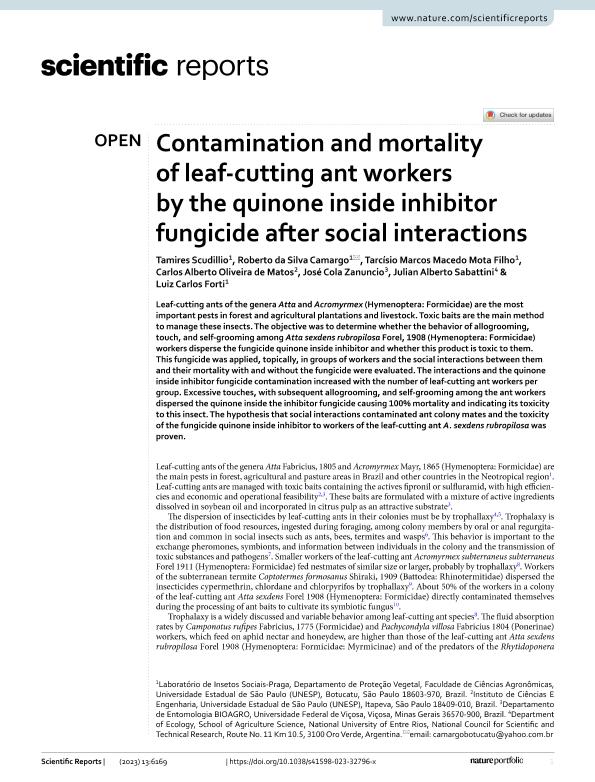Mostrar el registro sencillo del ítem
dc.contributor.author
Scudillio, Tamires
dc.contributor.author
Da Silva Camargo, Roberto

dc.contributor.author
Mota Filho, Tarcísio Marcos Macedo
dc.contributor.author
de Matos, Carlos Alberto Oliveira
dc.contributor.author
Zanuncio, José Cola
dc.contributor.author
Sabattini, Julian Alberto

dc.contributor.author
Forti, Luiz Carlos
dc.date.available
2023-12-14T13:43:58Z
dc.date.issued
2023-12
dc.identifier.citation
Scudillio, Tamires; Da Silva Camargo, Roberto; Mota Filho, Tarcísio Marcos Macedo; de Matos, Carlos Alberto Oliveira; Zanuncio, José Cola; et al.; Contamination and mortality of leaf-cutting ant workers by the quinone inside inhibitor fungicide after social interactions; Nature Research; Scientific Reports; 13; 1; 12-2023; 1-7
dc.identifier.uri
http://hdl.handle.net/11336/220338
dc.description.abstract
Leaf-cutting ants of the genera Atta and Acromyrmex (Hymenoptera: Formicidae) are the most important pests in forest and agricultural plantations and livestock. Toxic baits are the main method to manage these insects. The objective was to determine whether the behavior of allogrooming, touch, and self-grooming among Atta sexdens rubropilosa Forel, 1908 (Hymenoptera: Formicidae) workers disperse the fungicide quinone inside inhibitor and whether this product is toxic to them. This fungicide was applied, topically, in groups of workers and the social interactions between them and their mortality with and without the fungicide were evaluated. The interactions and the quinone inside inhibitor fungicide contamination increased with the number of leaf-cutting ant workers per group. Excessive touches, with subsequent allogrooming, and self-grooming among the ant workers dispersed the quinone inside the inhibitor fungicide causing 100% mortality and indicating its toxicity to this insect. The hypothesis that social interactions contaminated ant colony mates and the toxicity of the fungicide quinone inside inhibitor to workers of the leaf-cutting ant A. sexdens rubropilosa was proven.
dc.format
application/pdf
dc.language.iso
eng
dc.publisher
Nature Research
dc.rights
info:eu-repo/semantics/openAccess
dc.rights.uri
https://creativecommons.org/licenses/by-nc-sa/2.5/ar/
dc.subject
Contamination
dc.subject
mortality
dc.subject
leaf‑cutting
dc.subject.classification
Zoología, Ornitología, Entomología, Etología

dc.subject.classification
Ciencias Biológicas

dc.subject.classification
CIENCIAS NATURALES Y EXACTAS

dc.subject.classification
Ecología

dc.subject.classification
Ciencias Biológicas

dc.subject.classification
CIENCIAS NATURALES Y EXACTAS

dc.title
Contamination and mortality of leaf-cutting ant workers by the quinone inside inhibitor fungicide after social interactions
dc.type
info:eu-repo/semantics/article
dc.type
info:ar-repo/semantics/artículo
dc.type
info:eu-repo/semantics/publishedVersion
dc.date.updated
2023-12-11T17:51:34Z
dc.identifier.eissn
2045-2322
dc.journal.volume
13
dc.journal.number
1
dc.journal.pagination
1-7
dc.journal.pais
Reino Unido

dc.description.fil
Fil: Scudillio, Tamires. Universidade Estadual Paulista Julio de Mesquita Filho; Brasil
dc.description.fil
Fil: Da Silva Camargo, Roberto. Universidade Estadual Paulista Julio de Mesquita Filho; Brasil
dc.description.fil
Fil: Mota Filho, Tarcísio Marcos Macedo. Universidade Estadual Paulista Julio de Mesquita Filho; Brasil
dc.description.fil
Fil: de Matos, Carlos Alberto Oliveira. Universidade Estadual Paulista Julio de Mesquita Filho; Brasil
dc.description.fil
Fil: Zanuncio, José Cola. Universidade Federal de Viçosa; Brasil
dc.description.fil
Fil: Sabattini, Julian Alberto. Universidad Nacional de Entre Ríos; Argentina. Consejo Nacional de Investigaciones Científicas y Técnicas; Argentina
dc.description.fil
Fil: Forti, Luiz Carlos. Universidade Estadual Paulista Julio de Mesquita Filho; Brasil
dc.journal.title
Scientific Reports
dc.relation.alternativeid
info:eu-repo/semantics/altIdentifier/doi/http://dx.doi.org/10.1038/s41598-023-32796-x
dc.relation.alternativeid
info:eu-repo/semantics/altIdentifier/url/https://www.nature.com/articles/s41598-023-32796-x
Archivos asociados
